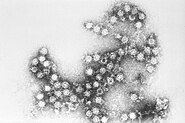Coxsackie B virus
| Coxsackie B virus | |
|---|---|

| |
| Coxsackie B4 virus | |
| Virus classification | |
| Group: | Group IV ((+)ssRNA)
|
| Family: | |
| Genus: | |
| Species: | |
| Subtype | |
|
Coxsackie B virus | |
Coxsackie B is the name of a group of six serotypes of pathogenic enteroviruses that trigger illness ranging from mild gastrointestinal distress to full-fledged pericarditis and myocarditis.[1]
Geographic distribution
The various members of the Coxsackie B group were discovered almost entirely in the United States, appearing originally in Connecticut, Ohio, New York, and Kentucky, although a sixth member of the group has been found in the Philippines.[1] That said, all six serotypes have a global distribution and are a relatively common cause of gastrointestinal upset.
Symptoms
Symptoms of infection with viruses in the Coxsackie B grouping include fever, headache, sore throat, gastrointestinal distress, as well as chest and muscle pain. This presentation is known as pleurodynia or Bornholm disease in many areas. Sufferers of chest pain should see a doctor immediately—in some cases, viruses in the Coxsackie B family progress to myocarditis or pericarditis, which can result in permanent heart damage or death. Coxsackie B virus infection may also induce aseptic meningitis. As a group, they are the most common cause of unexpected sudden death, and may account for up to 50% of such cases.[2] The incubation period for the Coxsackie B viruses is, like most of the Enteroviridae, highly variable, ranging from 2 to 35 days, and illness may last for up to two weeks, but may resolve as quickly as two days. Infection usually occurs between the months of June and October in temperate Northern Hemisphere regions.[1]
Diagnosis
Enterovirus infection is diagnosed mainly via serological tests such as ELISA[3] and from cell culture.[1] Because the same level and type of care is given regardless of type of Coxsackie B infection, it is mostly unnecessary for treatment purposes to diagnose which virus is causing the symptoms in question, though it may be epidemiologically useful.
Viral structure and function
Coxsackie B viruses are single-strand positive-sense RNA viruses that are resistant to a wide variety of chemical treatments. The viral particles themselves are roughly 30 nm icosahedrons.[4] The virus is most frequently distributed via the fecal-oral route, and infection commonly occurs after eating contaminated food. Coxsackie B viruses are cytolytic, and Coxsackie B2 and B5 viruses have been implicated in hand, foot and mouth disease as well as respiratory infection.[1] Infection in infants is mostly asymptomatic, but sometimes results in the death of the infant, often due to myocarditis.[5] Birth defects may also be present in a Coxsackie B infected infant.
Diabetes
The B4 strain of Coxsackie viruses has been discovered to be a possible cause of Diabetes mellitus type 1. Other research points more broadly to the Coxsackie B virus generally.
Treatment and prevention
As of 2008[update], there is no well-accepted treatment for the Coxsackie B group of viruses.[1] Palliative care is available, however, and patients suffering chest pain or stiffness of the neck should be examined for signs of cardiac or central nervous system involvement, respectively. Some measure of prevention can usually be achieved by basic sanitation on the part of food-service workers, though the viruses are highly contagious. Care should be taken in washing ones hands and in cleaning the body after swimming. In the event of Coxsackie-induced myocarditis or pericarditis, antiinflammatories can be given to reduce damage to the heart muscle.
References
- ^ a b c d e f Fields, Bernard N. (1985). Fields Virology. New York: Raven Press. pp. 739–794. ISBN 0-88167-026-X.
{{cite book}}: Unknown parameter|coauthors=ignored (|author=suggested) (help) - ^ Maze, S. S. (1990). "Myocarditis: unresolved issues in diagnosis and treatment". Clinical Cardiology. 13 (2): 69–79. doi:10.1002/clc.4960130203. PMID 2407397.
{{cite journal}}:|access-date=requires|url=(help); Unknown parameter|coauthors=ignored (|author=suggested) (help); Unknown parameter|month=ignored (help) - ^ Bell, Eleanor J. (1986). "Mu-Antibody capture elisa for the rapid diagnosis of enterovirus infections in patients with aseptic meningitis". Journal of Medical Virology. 19 (3): 213–217. doi:10.1002/jmv.1890190303. PMID 3016164.
{{cite journal}}:|access-date=requires|url=(help); Unknown parameter|coauthors=ignored (|author=suggested) (help) - ^ Libby, Karen (2000). "Coxsackie B virus pathogen card". Retrieved 2007-09-02.
- ^ Kaplan, M. H. (1983 November-December). "Group B coxsackievirus infections in infants younger than three months of age: a serious childhood illness". Reviews of Infectious Diseases. 5 (6): 1019–1032. PMID 6318288.
{{cite journal}}:|access-date=requires|url=(help); Check date values in:|date=(help); Unknown parameter|coauthors=ignored (|author=suggested) (help)
